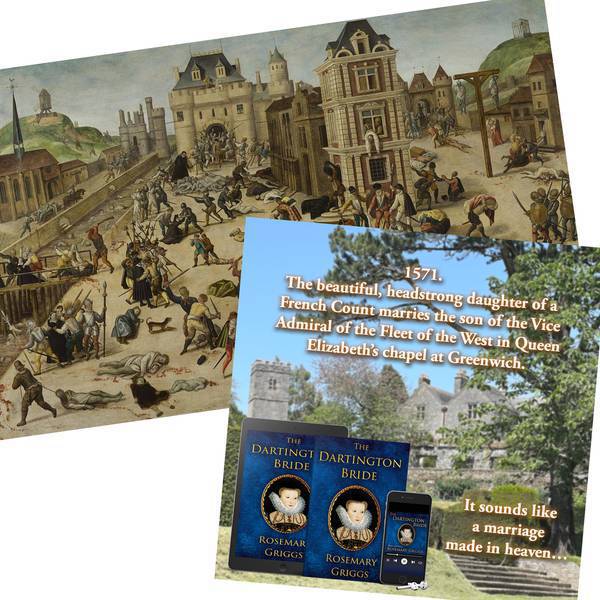
The St Bartholomew’s Day Massacre.
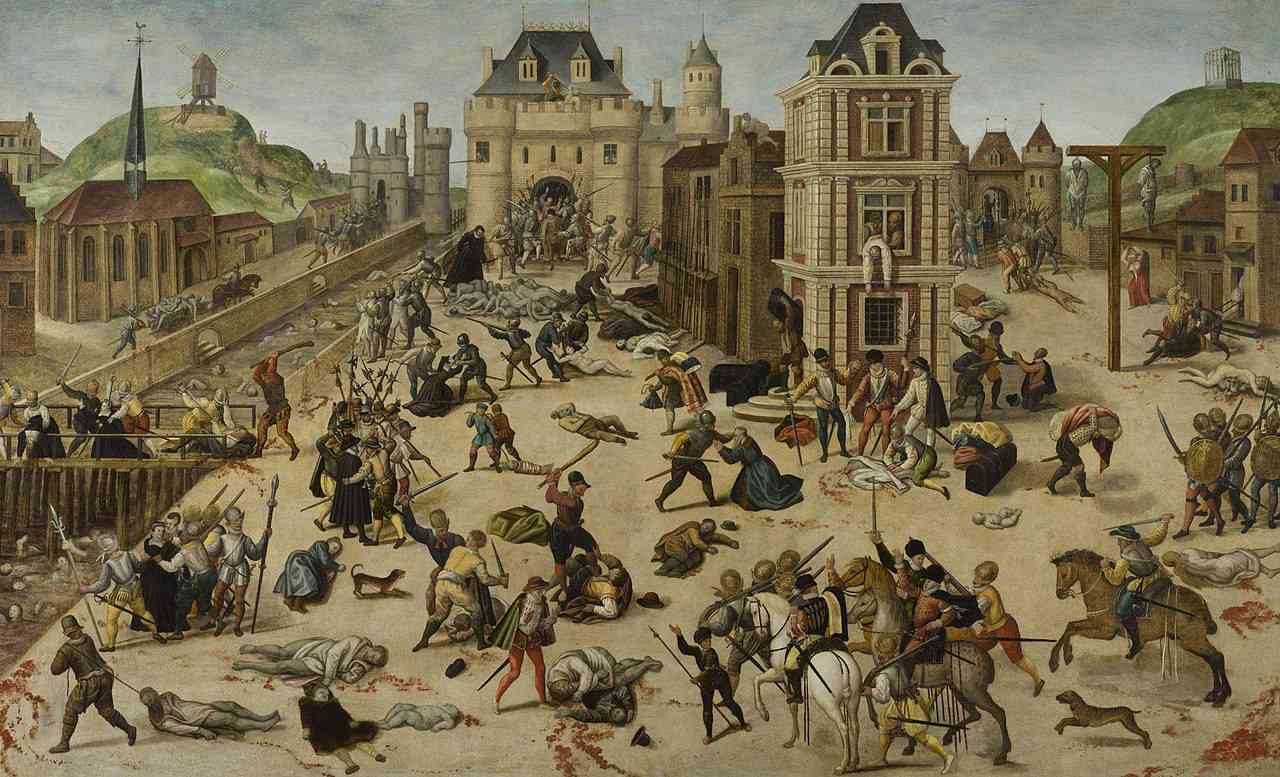
The St Bartholomew’s Day Massacre by Francois Dubois (c 1572-84) image sourced via Wikimedia Commons
Sir Francis Walsingham, the English Ambassador to the French Court, sent a letter to Sir Thomas Smith, the Secretary of State to Queen Elizabeth I, on 2 September 1572. In his letter, Walsingham used the typical diplomatic language, but there was one passage where he couldn't hide his anger.
Walsingham doubted the King’s promise that his troops would punish those who killed the three Englishmen. He makes it clear in his letter that he thought it unlikely they could even apprehend those responsible, since the killing was so widespread, writing:-
‘…the dysorder beinge so generall, the sworde being commytted to the common people.’
Walsingham penned the letter the day after he met King Charles IX of France.
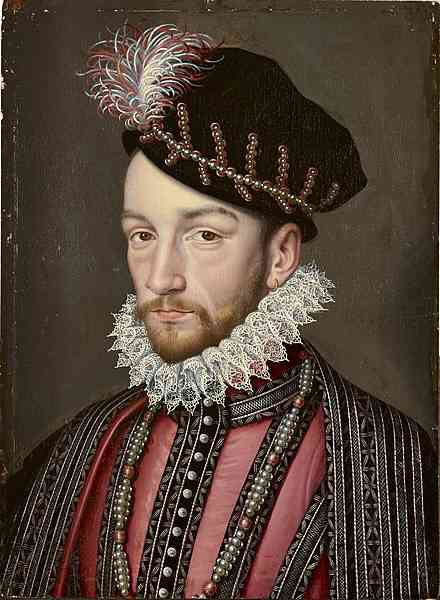
Portrait of Charles IX of France(1550-1574) in the public domain - Collection at Palace of Versailles, image sourced via Wikimedia Commons
During the meeting, he questioned the king about three English subjects who had died in the horrific violence that later became known as the St Bartholomew’s Day Massacre.
It’s no wonder the English Ambassador was angry. He experienced the violence himself when rioters surrounded his house.
It is perhaps fortunate that the ambassador’s residence was not in the most fashionable part of the city. Walsingham claimed he could not afford a more prestigious address. So before the mob reached the Saint Marceau district, he had time to take in many Englishmen and several French Huguenots before he secured the doors.
One of the Huguenot noblemen sheltering in the ambassador’s house, François de Beauvais, Sieur de Briquemault, slipped into Walsingham’s house, past the royal guards, disguised as a butcher. Having seen his son killed in front of him, he must have thought he was safe.
Ursula, Walsingham’s pregnant wife, and his five-year-old daughter, Frances, were with him in Paris. Sir Philip Sydney, who would in time marry Frances Walsingham, also sheltered in the ambassador’s house. It must have been terrifying for them, as they huddled together behind barred doors, praying that the baying mob would not break in.
They remained inside for several days. At last, a Catholic nobleman summoned the royal troops to guard the house. The king’s soldiers discovered Briquemault hiding in the stables. Despite Walsingham’s pleas, the king ordered Briquemault’s execution.
At his meeting with Walsingham on 1 September, King Charles maintained he gave the order to attack to suppress an uprising. He alleged Coligny had been the ringleader in a plot against the crown.
Sir Francis Walsingham was deeply affected by his experiences in Paris in August 1572. During discussions about a potential marriage between Queen Elizabeth and Francis, Duke of Alençon, who was a Catholic, Walsingham described it as the most horrific sight he had ever seen. He warned of the possibility of religious riots erupting in England should the planned marriage with Alençon go ahead.
Background
The French Wars of Religion started in 1562, and for ten years split the country in two. Periods of fierce fighting interrupted times of uneasy truce, with neither side gained lasting advantage.
Following the treaty of St Germain-en-Laye, signed in 1570, Protestant leaders made a cautious return to the royal court. However, some Catholics, including the followers of the Duc de Guise, believed the treaty went too far. Tensions rose again.
Catherine de Medici, the king’s mother, was a fervent Catholic. However, she recognised that the country could not afford to remain in a state of civil war indefinitely. She could see the sense of relative religious tolerance. She believed that the marriage Protestant Henry of Navarre, to Catholic King Charles’ sister, Marguerite, would cement the peace between the two religious factions. Catherine worked hard to persuade Henry of Navarre’s mother, Jeanne D’Albret, to agree to the wedding, which took place on 18 August 1572. Many Huguenots converged on Paris to join in the celebrations.
With so many Protestants in a violently anti-Huguenot Paris, the atmosphere grew tense. Despite this, Admiral de Coligny, the Protestant leader, opted to remain for a few days after the wedding. Coligny thought uniting against a common enemy might foster better relations between the warring factions. With that in mind, he hoped to persuade King Charles to send French forces to the Spanish Netherlands (Flanders) to support William of Orange against Philip II of Spain.
On the morning of 22 August, as he returned to his lodgings from a meeting, an unknown assailant shot and wounded Coligny. The would-be assassin fired from a house believed to be occupied by supporters of the Duc de Guise. The Guise family, who were very much opposed to the Flanders war, were popular with the Catholic population of Paris. They also had a long running personal feud with Coligny, who Henry Duc de Guise held responsible for the death of his father during the Siege of Orleans in 1563.
The Admiral suffered only minor injuries, but alarmed Huguenot leaders gathered at his house to discuss what had happened. The king visited Coligny and assured him they would catch and punish those responsible.
But, during the night of 23 August, the bells of Saint-Germain-l’Auxerrois gave the signal for royal soldiers to burst into Coligny’s lodgings. They murdered him and threw his body out of the window onto the street and slaughtered a man Huguenot noblemen.
These targeted murders set the fuse for an explosion of unimaginable violence. Mobs hunted down Protestants. They killed everyone who did not show their Catholic allegiance by wearing a white armband or a white cross in their hats. They showed no mercy, not even to women and children. The streets ran red with blood. The killings continued throughout the city for three days. Some sources suggest that as many 3,000 Protestants perished in Paris. Most of the citizens of Paris were fervent Catholics. When the king’s soldiers attacked and murdered Huguenot leaders, people took it as a signal to attack their Protestant neighbours in the city. The killing spree on the streets or Paris went on for several days and spread to other towns and cities. France was no longer a safe place for Huguenots.
In the past, some historians have blamed Catherine de Medici for the atrocity. They suggest she orchestrated the assassination because she was jealous of Coligny’s influence over the young king and his plans for war with Spain. However, recent scholars argue she is unlikely to have plotted a massacre of the people with whom she has been trying for decades to negotiate peace.
Sir Arthur Champernowne of Dartington Hall
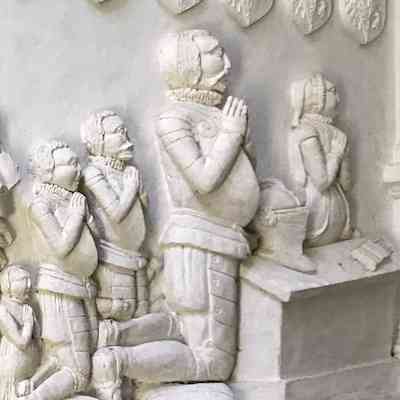
Sir Arthur Champernowne and his family, as depicted on a monument in the tower of Old St Mary’s Church, Dartington Hall. (photo my own)
Sir Arthur Champernowne came from a prominent Devon family. A staunch Protestant, he gave active support to the French Huguenots. As Vice-Admiral of the Fleet of the West, he turned a blind eye to the actions of privateers working for Jeanne d’Albret, Queen of Navarre, against the ships of Catholic Spain. Sometimes he even co-operated with them.
In 1568, Sir Arthur’s nephew, Henry Champernowne, persuaded Queen Elizabeth to allow him to lead an expedition to France. At the head of one hundred English soldiers, he fought alongside the Huguenots at the battles of Jarnac and Moncontour. Many of his cousins joined him, probably including a young Sir Walter Raleigh.
While in France, Henry sent regular reports back to Queen Elizabeth and her council. After he died in La Rochelle in 1570, Sir Arthur continued to supply intelligence to Walsingham and Lord Burghley, assisted by his son Gawen.
In June 1572, Sir Arthur travelled to Paris with Sir Henry Middlemore to meet Admiral Coligny. They went to discuss the possibilities for joint intervention against Spain in the Low Countries. He returned to Devon before the tragic events of St Bartholomew’s Day. It’s possible, however, that Gawen remained in France and was in Paris. He may even have been one of those hiding in Walsingham’s house on that August night.
Gabriel de Lorges, Comte de Montgomery
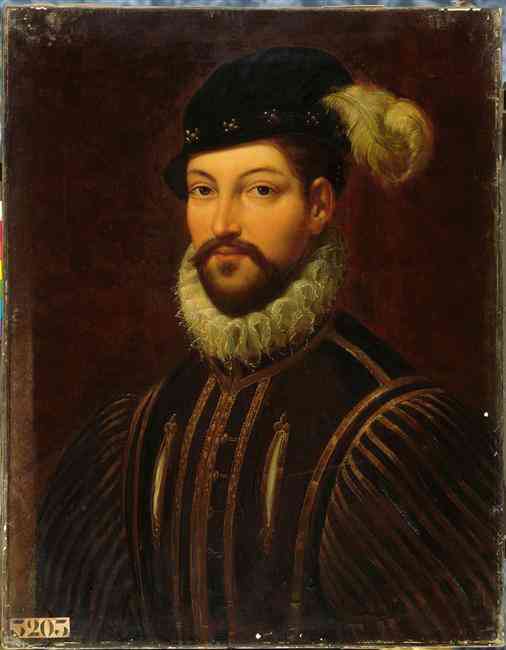
Gabriel de Lorges, Comte de Montgomery, Copy from an original kept at the Château de Beauregard; commissioned by Louis-Philippe in 1834 — image sourced via Wikimedia Commons
Gabriel de Lorges, Comte de Montgomery, a Huguenot general, was in Paris for the wedding celebrations. He was not at Coligny’s house near the Louvre during the attack there. Instead, he was asleep in his house in Faubourg St Germain on the other side of the River Seine.
The story goes that a man swam across the river to warn Gabriel that he must flee. He made his escape on horseback, with around fifty or sixty others. Two hundred or more soldiers pursued them, led by the Duc de Guise. If a locked gate and the search for keys hadn’t held up the pursuers, they would have caught Gabriel and his companions. That brief delay gave them a head start, and after a while, the Duc and his men gave up on the chase. When Gabriel reached the coast, he took ship to Jersey. His wife Isabeau, and all of his family, left the family chateau at Ducey, Normandy, when they heard the news of the massacre. They joined Gabriel, and in disguise, the entire party made their way to England.
By this time, Gabriel’s daughter, Roberda, was Gawen’s wife. Sir Arthur welcomed Gabriel and the whole Montgomery family to Dartington Hall in Devon as refugees. Soon after they arrived, he sent a letter to Queen Elizabeth, proposing the raising of an army to relieve the Protestants in France. The Montgomerys stayed in England for some time, while Gabríel planned further actions against the catholics in France and lobbied Queen Elizabeth for funds and support.
Many Huguenots fled persecution and sought shelter in La Rochelle. King Charles IX of France was dead, replaced by his brother, Henry. Giving up pretensions to the throne of Poland, the 22-year-old king gathered his armies and laid siege to La Rochelle. The people there resisted, but rations were running low. Gabriel appointed his son-in-law, Gawen, co-commander of an attempt to relieve the town by ship from England. The enterprise failed, leaving Gawen humiliated. In addition, the Montgomerys had yet to pay the substantial dowry agreed in Roberda’s marriage. The non-payment if the dowry festered between the two families for years.
Rosemary Griggs
2 September 2024
I have drawn this article together from a wide range of sources including
Estelle Paranque — Blood , Fire and Gold
William A Heap — Elizabeth'‘s French Wars, 1562 - 1598
Entries in ‘The Elizabethan Court Day by Day’, Folgerpedia
https://folgerpedia.folger.edu/mediawiki/media/images_pedia_folgerpedia_mw/5/57/ECDbD_1572.pdf
Entries in The Calendar of State Papers domestic Elizabeth 1572/74 accessed via British History Online
Details of Walsingham’s letter are included in an excellent post in the British Library Medieval Manuscripts Blog
https://blogs.bl.uk/digitisedmanuscripts/2022/08/massacre-on-the-streets-of-paris.html
If you have enjoyed this post please share on your social media using the links below
